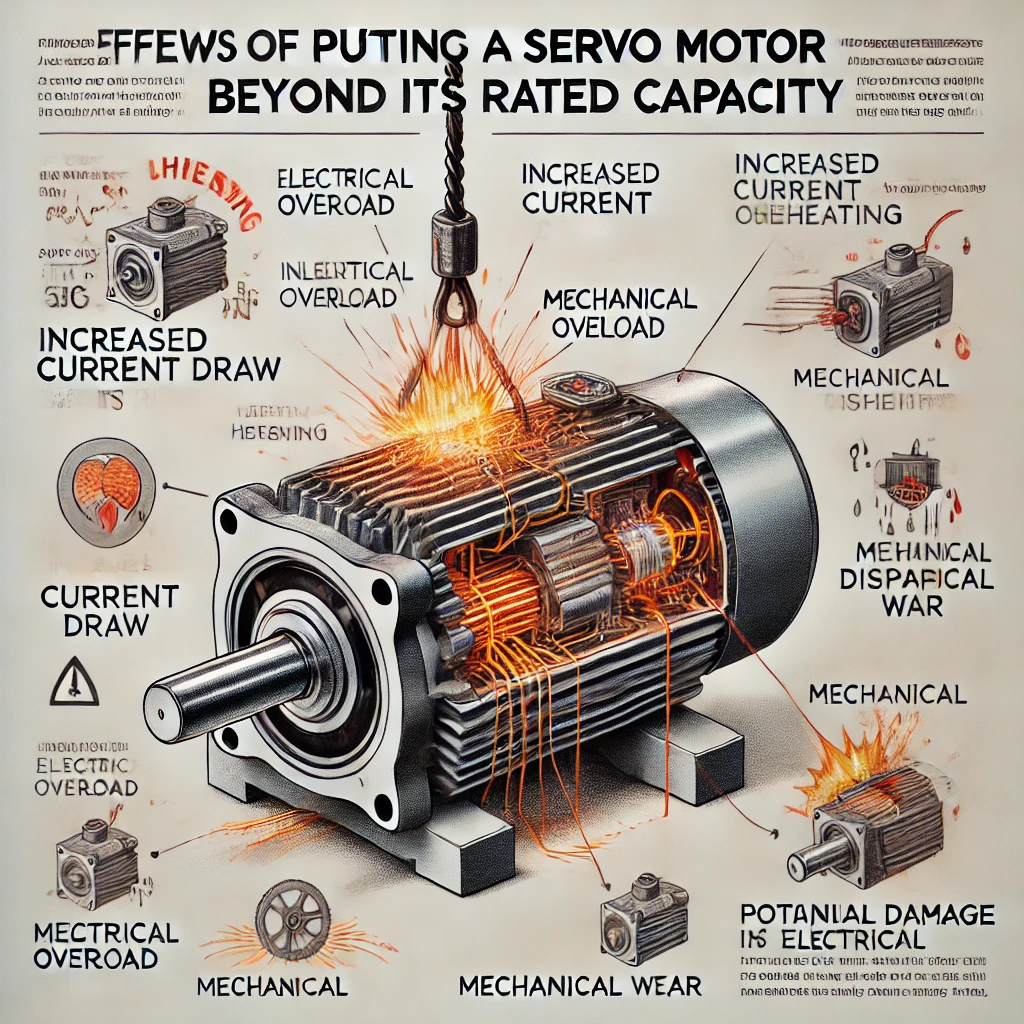
When a servo motor is put under stress, such as lifting a weight beyond its rated capacity, several things can happen to the electrical system and the servo itself. Understanding these effects requires a look at the electrical and mechanical principles at play.
Servo Motor Basics
A servo motor is a rotary actuator that allows for precise control of angular position, velocity, and acceleration. It consists of a motor coupled to a sensor for position feedback. The motor is controlled by sending a PWM (Pulse Width Modulation) signal, and the feedback allows for precise control of the motor’s movement.
Electrical and Mechanical Effects of Overloading a Servo Motor
Increased Current Draw:
- When a servo motor attempts to lift a weight beyond its rated capacity (e.g., 11lbs when it is rated for 10lbs), it experiences a higher mechanical load.
- To overcome this additional load, the motor requires more torque.
- To generate more torque, the motor draws more current from the power supply.
Power Supply Stress:
- The increased current draw can strain the power supply. If the power supply is not capable of providing the necessary current, its voltage may drop, leading to a condition called "brownout."
- Brownout can cause the servo to malfunction, reset, or stop functioning altogether.
Heat Generation:
- Higher current through the motor windings generates more heat due to the resistive losses (Joule heating, given by (P = I^2R)).
- Excessive heat can damage the motor windings, insulation, and other components, potentially leading to permanent damage.
Voltage Drop:
- If the wires and connectors are not adequately rated for the higher current, there can be a significant voltage drop across them. This reduces the effective voltage reaching the motor, further complicating performance.
Controller Overload:
- The servo controller, which regulates the position and power delivered to the motor, might not be designed to handle the increased current. This can lead to overheating of the controller’s components and potential failure.
Servo Feedback Loop Stress:
- The feedback mechanism, typically a potentiometer or encoder, works harder to maintain the position. If the load is too high, the feedback system might oscillate, causing jitter or instability in the servo’s position.
Example Scenario: Rated for 10lbs, Attempting to Lift 11lbs
Let’s consider a servo rated for a maximum lift capacity of 10lbs, attempting to lift 11lbs.
Current and Voltage Dynamics:
- Normal Operation (10lbs): Assume the servo draws 1A at 6V to lift 10lbs.
- Overload Condition (11lbs): The servo now attempts to lift 11lbs. The current draw might increase significantly, say to 1.5A or more.
Power Supply Impact:
- If the power supply is marginally rated (e.g., a 6V, 1.5A supply), it might struggle to provide the necessary current without a voltage drop.
- This voltage drop could cause the servo to underperform or reset.
Thermal Effects:
- The increased current leads to higher power dissipation within the servo motor ((P = I^2R)).
- The motor gets hotter. If the internal temperature exceeds the design limits, thermal protection mechanisms might engage, or permanent damage could occur.
Controller Stress:
- The servo controller might be rated for currents up to 1A continuous. Drawing 1.5A can overheat the controller, causing thermal shutdown or damage.
Protection Mechanisms
Most high-quality servos and controllers have built-in protection mechanisms to handle such scenarios:
- Thermal Protection: Shuts down the motor if it gets too hot.
- Current Limiting: Prevents the motor from drawing excessive current.
- Overload Protection: Stops the motor if the load exceeds the rated capacity.
Monitoring and Logging System for Servo Stress
To ensure the health and longevity of your servo motor system, you can implement an independent monitoring and logging system. This system will run in parallel with the normal control power and monitor the current draw, voltage, and stress of the servo. Here’s how you can set up such a system using an Arduino and I2C (Inter-Integrated Circuit) sensors for monitoring.
Components Needed:
- Arduino Uno (or any compatible board)
- Current Sensor (ACS712 or INA219)
- Voltage Sensor (e.g., a voltage divider or INA219)
- Temperature Sensor (e.g., TMP102 or LM35)
- Data Logging Shield (with SD card slot)
- I2C OLED Display (optional, for real-time monitoring)
- Breadboard and Connecting Wires
Circuit Diagram
- Current Sensor: Connect the ACS712 or INA219 current sensor to the servo motor power line.
- Voltage Sensor: Use the INA219 (which can measure both current and voltage) or a simple voltage divider to measure the voltage across the servo motor.
- Temperature Sensor: Place the temperature sensor close to the servo motor to monitor its operating temperature.
Connections:
ACS712 Current Sensor:
- VCC to 5V on Arduino
- GND to GND on Arduino
- OUT to A0 on Arduino
- Connect the servo motor power line through the sensor.
INA219 Sensor:
- VCC to 5V on Arduino
- GND to GND on Arduino
- SCL to A5 (SCL) on Arduino
- SDA to A4 (SDA) on Arduino
- VIN+ and VIN- in series with the servo motor power line.
TMP102 Temperature Sensor:
- VCC to 3.3V on Arduino
- GND to GND on Arduino
- SCL to A5 (SCL) on Arduino
- SDA to A4 (SDA) on Arduino
Data Logging Shield:
- Directly stackable on Arduino (it uses SPI for SD card communication)
I2C OLED Display (Optional):
- VCC to 3.3V on Arduino
- GND to GND on Arduino
- SCL to A5 (SCL) on Arduino
- SDA to A4 (SDA) on Arduino
Arduino Code
Here’s an example code to monitor and log the data:
#include <Wire.h>
#include <Adafruit_INA219.h>
#include <Adafruit_SSD1306.h>
#include <SD.h>
#include <SPI.h>
#include <Adafruit_TMP102.h>
// Create instances for sensors
Adafruit_INA219 ina219;
Adafruit_TMP102 tmp102;
File logFile;
// SD Card pin configuration
const int chipSelect = 10;
// OLED Display configuration
#define SCREEN_WIDTH 128
#define SCREEN_HEIGHT 64
Adafruit_SSD1306 display(SCREEN_WIDTH, SCREEN_HEIGHT, &Wire, -1);
void setup() {
Serial.begin(9600);
// Initialize INA219
if (!ina219.begin()) {
Serial.println("Failed to find INA219 chip");
while (1);
}
// Initialize TMP102
if (!tmp102.begin(0x48)) {
Serial.println("Failed to find TMP102 chip");
while (1);
}
// Initialize SD card
if (!SD.begin(chipSelect)) {
Serial.println("SD card initialization failed");
return;
}
// Create or open the log file
logFile = SD.open("servolog.txt", FILE_WRITE);
if (!logFile) {
Serial.println("Failed to open log file");
return;
}
// Initialize OLED display
if (!display.begin(SSD1306_I2C_ADDRESS, 0x3C)) {
Serial.println("SSD1306 allocation failed");
while (1);
}
display.clearDisplay();
display.setTextSize(1);
display.setTextColor(SSD1306_WHITE);
display.setCursor(0, 0);
display.print("Servo Monitor Init");
display.display();
delay(2000);
}
void loop() {
float shuntvoltage = 0;
float busvoltage = 0;
float current_mA = 0;
float loadvoltage = 0;
float power_mW = 0;
float temperature_C = 0;
// Read INA219 sensor
shuntvoltage = ina219.getShuntVoltage_mV();
busvoltage = ina219.getBusVoltage_V();
current_mA = ina219.getCurrent_mA();
power_mW = ina219.getPower_mW();
loadvoltage = busvoltage + (shuntvoltage / 1000);
// Read TMP102 sensor
temperature_C = tmp102.readTempC();
// Log data to SD card
logFile.print("Load Voltage: ");
logFile.print(loadvoltage);
logFile.print(" V, Current: ");
logFile.print(current_mA);
logFile.print(" mA, Power: ");
logFile.print(power_mW);
logFile.print(" mW, Temperature: ");
logFile.print(temperature_C);
logFile.println(" C");
logFile.flush(); // Ensure data is written to the file
// Display data on OLED
display.clearDisplay();
display.setCursor(0, 0);
display.print("Voltage: ");
display.print(loadvoltage);
display.println(" V");
display.print("Current: ");
display.print(current_mA);
display.println(" mA");
display.print("Power: ");
display.print(power_mW);
display.println(" mW");
display.print("Temp: ");
display.print(temperature_C);
display.println(" C");
display.display();
// Print data to Serial Monitor
Serial.print("Load Voltage: ");
Serial.print(loadvoltage);
Serial.print(" V, Current: ");
Serial.print(current_mA);
Serial.print(" mA, Power: ");
Serial.print(power_mW);
Serial.print(" mW, Temperature: ");
Serial.print(temperature_C);
Serial.println(" C");
delay(1000); // Wait for 1 second before next read
}Explanation
Sensors Initialization:
- The INA219 sensor is used to measure both the current and voltage across the servo motor.
- The TMP102 sensor measures the temperature near the servo motor to monitor for overheating.
Data Logging:
- The data logging shield records voltage, current, power, and temperature readings to an SD card.
- This allows for historical analysis and troubleshooting.
Real-Time Monitoring:
- An optional I2C OLED display provides real-time feedback of the monitored parameters.
- The display shows voltage, current, power, and temperature, allowing for immediate detection of issues.
Parallel Operation:
- This monitoring system operates independently of the main servo control logic, ensuring that it does not interfere with normal servo operations.
- It provides a safeguard and diagnostic tool to monitor and log the servo’s operating conditions continuously.
By implementing this monitoring and logging system, you can ensure that your servo motor operates within its safe limits and quickly identify and troubleshoot any issues related to overloading or stress.
Conclusion
When a servo motor is put under stress by lifting a weight beyond its rated capacity, it draws more current, which can strain the power supply, generate excessive heat, and potentially damage the servo motor and controller. Understanding these dynamics helps in designing systems with appropriate safety margins and protection mechanisms to prevent damage and ensure reliable operation.



